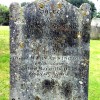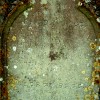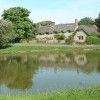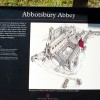You might think this quiet backwater close to Maiden Newton hardly cries out for our attention; after all its population amounts to just sixty souls (2001 census). Yet we have four articles featuring the parish and the cause of all the interest is one family who came here from Somerset in the middle of the 16th century.
The Sydenham family moved into the Manor House, a charming residence with interesting old chimneys, gables and mullions topped off by a large stone eagle, the emblem of the Norman Lord, Gilbert de Aquila, that adorns its impressive west façade.
Before their arrival though, there is evidence here of early settlement with Round Barrows and some remains from the Roman era. Of particular interest a tessellated pavement was discovered near the old Manor house and in 1935 half of this pavement was uncovered again when it was noted it had guilloche borders, foliage, and a dolphin.
Recorded as Wenfrot in Domesday Book and down through the centuries as Winfrot Gileberti de Aquila, Wynford Aquile and, in 1288, as Wynfrod Egle. Wynford is from a Celtic name for a tributary of the River Frome translating to white or bright stream. Eagle is a reference to the medieval family of Gilbert del Egla; he came from L’Aigle in France.
The parish church dedicated to St. Lawrence stands alone near the site of an earlier church. Built in 1842 by G & H Osborn its plain minimalist style is saved by the 15th century chancel arch from the earlier building. By the west porch is a late 15th century tympanum displaying an eagle (or wyverns) with inscriptions: Mahald de l’egele’ a reference to Mathilda Eagle and Alvi me feci a reference to the sculptor Alvi who produced it. The church was formerly a chapelry of Toller Fratrum and was later annexed to it as a perpetual curacy.
In the churchyard most of the memorials are to recent inhabitants of the parish and surprisingly there is no mention of the Sydenham family whose relatively brief sojourn here makes for compelling reading. A father and sons fought for Cromwell, revenged their mother’s murder by a Royalist officer and in quieter times provided the father of British medicine; but at the turn of the 17th to 18th century a scandalous lottery scam brought the family only ruin and disgrace.
The estate was later purchased by another Somerset family, the Bests, for whom the baronetcy of Wynford was established in 1829.
Note: Elsewhere in this category you will find the story of this prominent family, a biographical piece about the most famous son, and an article about the scandalous events leading to the family’s demise.



